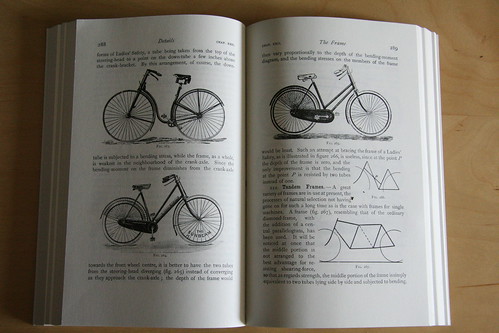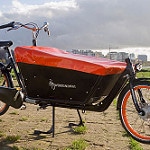What’s really new in bicycle world?
TweetMy friend Will Fleishell sent me a link to the great looking Metz Bicycle Museum in Freehold, NJ (USA). They’ve a broad collection of bikes, tricycles and quadricycles from early bike-dom (the 1860’s) to about 1900. Some look remarkably modern while others are of formats that have long since disappeared. Check out this tandem quadricycle that can be converted into no less than two types of high-wheeler bikes, for example:
The first bike that caught my eye though was this 1890 “lamplighter’s bike” from New York City. You see a 250cm bike was the perfect way to reach a flame into hundreds of streetlamps each evening. Just ride along and dab the burning stick into each oil lamp as it comes along.
But wait a minute, you object, isn’t this just a “tall bike” like those weird anarchist dudes do their jousting on? Yes, exactly… except that they just reinvented it, uglier and worse, 100 years later. And this is exactly my point: Most of the real “invention” and “development” of the bicycle occurred more than 100 years ago, back when the bicycle was one of the pinnacles of technology, and certainly the highest tech thing an ordinary person could get their hands on. As I recall some of the things that were developed for bicycles: steel tubing, ball bearings, pneumatic tires, the tensioned spoke wheel, the roller chain drive and the list goes on. People often poo-poo of the achievements of the Wright Brothers because they were bike makers by trade, but this completely misses the point that the bicycle techies of that day were amongst the best suited to be experimenting with aerodynamics (which nobody understood yet) and lightweight, efficient structures.
In 1896 Archibald Sharp wrote what is probably still the most comprehensive book on bicycle technology “Bicycles and Tricycles, An Elementary Treatise on Their Design and Construction”. It’s 400 pages of detailed analysis of bicycle design. From the MIT Press site (they reprinted it in 1979 and my copy is one of these):
It begins with a general exposition of mechanical principles: dynamic, static, and straining forces. It then covers successive experiments at bicycle and tricycle design, including several “mechanical monstrosities.”
With the aid of elegant, sometimes humorous drawings, the book examines various designs for their relative stability, steering advantages, gearing and resistance properties. The final selection discusses the design of individual components in detail, including the frame (from the point of view of stress analysis); wheels; bearings; chains and chain gearing; toothed-wheel gearing; the lever-and-crank gear; tires; pedals, cranks and bottom brackets; springs and saddles; and brakes.
Even if you couldn’t read English or simply can’t be bothered to follow the scientific explanations the illustrations would be worth looking at. There are images and often scorching analysis of all sorts of bike and component designs that have been unwittingly (or knowingly?) reinvented in the intervening 120 years: disk wheels, belt drives, suspension frames and forks, shaft drive, two-speed epicyclic cranks and many more examples.
“Bicycles and Tricycles” is again out of print but it should be possible to find a second-hand copy. ISBN-10: 0-262-69066-7, ISBN-13: 978-0-262-69066-9
My point isn’t that the bicycle hasn’t evolved in over 100 years; It certainly has but largely in details. The basics elements have long been well understood, and unfortunately seem to get forgotten regularly. Thus simultaneous with the evolution of brakes, gearing and other details is constant de-evolution and re-invention of the basic design. A few examples of how current bikes are often actually worse than their predecessors:
Here is thus where we focus our efforts at WorkCycles; not attempting to reinvent the wheel, but merely refine it. This can require searching back a few steps to see where things went wrong (city bike ergonomics) or developing our own knowledge where there doesn’t seem to be any useful history to rely on (steering geometry for very heavily loaded bikes). All the while the designs remain timeless, but not for the sake of “retro style”. We’re either maintaining highly developed designs that are still fundamentally sound or creating new ones with the recognition that the products of evolution rarely fall far from the apple tree.






















October 1st, 2009 at 19:31
It’s on Google Books!
http://books.google.com/books?id=CNwWAAAAYAAJ
I love the bike on page 289.
October 1st, 2009 at 22:04
I suppose the difference between then and now is Comfort. All the little Tweaks down through the Years to try and improve things. Two Steps forward and one backwards,sometimes they make a complete Hames of Designs and have to Recall Bikes to try and Fix things. The improvements that can be made are mostly Ergonomic like more Wider Hand Grips for the Handlebars or better Pedals that your Feet do not Slip off in the Wet. Or making the Clearance between the Front Wheel and your Foot better so you do not Hit off the Wheel when turning a Corner. Some Bikes are Notorious for that,even Top of the Range Racing Bikes.
October 2nd, 2009 at 01:20
I found it at the library of the local university, very interesting. I especially like the section on perfectly braced frames. The author also includes a few bicycle parts of his own invention that would be interesting to try out.
October 8th, 2009 at 14:12
Interesting that you say ‘The generally too high crank axles that make it difficult for the rider to reach the ground when the saddle is adjusted to a biomechanically suitable height ‘
I have a 70cm Kruisframe. It’s a beauty but suffers from that very flaw.
Seems like there is still work to do there!
October 11th, 2009 at 22:04
Simon,
You’re correct and I didn’t claim to be exempt from my criticism. Some of our frames (the traditional Dutch city bikes) are not of our own design… yet. We’re slowly working on developing the entire line.
October 12th, 2009 at 11:01
Henry,
No criticism specifically of Workcycles was intended.
It was really just an observation that in over 100 years of evolution the cycle industry can still get the basics wrong.
October 12th, 2009 at 11:52
Simon,
Exactly. With each step forward it seems that somebody ignores or forgets something else important. WorkCycles is just a little company and sometimes we have to work with what we can get while we slowly develop our own parts that more fully meet our demands. Even then it’s not economically practical to make some parts in quantities of just a couple thousands units or less.